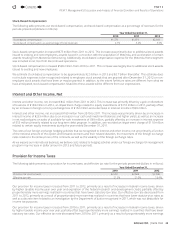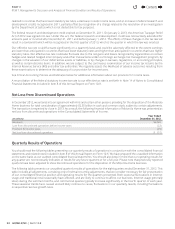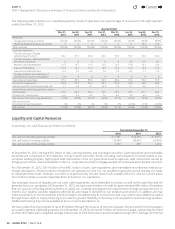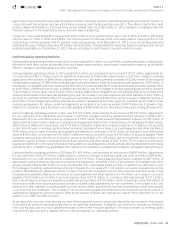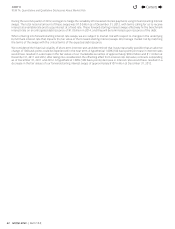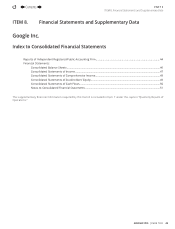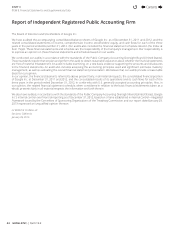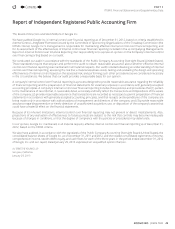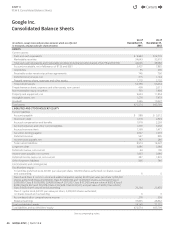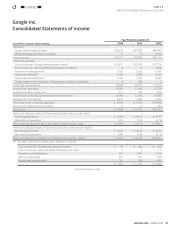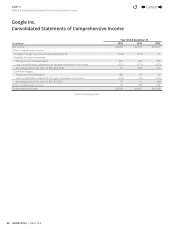Google 2012 Annual Report Download - page 46
Download and view the complete annual report
Please find page 46 of the 2012 Google annual report below. You can navigate through the pages in the report by either clicking on the pages listed below, or by using the keyword search tool below to find specific information within the annual report.
40 GOOGLE INC. |Form10-K
PART II
ITEM7.Management’s Discussion and Analysis of Financial Condition and Results ofOperations
the amounts recorded, such diff erences will impact the provision for income taxes in the period in which such determination
is made. The provision for income taxes includes the impact of reserve provisions and changes to reserves that are considered
appropriate, as well as the related net interest.
Our eff ective tax rates have diff ered from the statutory rate primarily due to the tax impact of foreign operations, state taxes,
certain benefi ts realized related to stock-based award activities, and research and experimentation tax credits. The eff ective
tax rates were 21.2%, 21.0%, and 19.4% for 2010, 2011, and 2012. Our future eff ective tax rates could be adversely aff ected
by earnings being lower than anticipated in countries that have lower statutory rates and higher than anticipated in countries
that have higher statutory rates, the net gains and losses recognized by legal entities on certain hedges and related hedged
intercompany and other transactions under our foreign exchange risk management program, changes in the valuation of our
deferred tax assets or liabilities, or changes in tax laws, regulations, or accounting principles, as well as certain discrete items.
In addition, we are subject to the continuous examination of our income tax returns by the IRS and other tax authorities. We
regularly assess the likelihood of adverse outcomes resulting from these examinations to determine the adequacy of our
provision for income taxes.
Loss Contingencies
We are regularly subject to claims, suits, government investigations, and other proceedings involving competition and antitrust,
intellectual property, privacy, tax, labor and employment, commercial disputes, content generated by our users, goods and services
off ered by advertisers or publishers using our platforms, and other matters. Certain of these matters include speculative claims
for substantial or indeterminate amounts of damages. We record a liability when we believe that it is both probable that a loss
has been incurred, and the amount can be reasonably estimated. We evaluate, on a monthly basis, developments in our legal
matters that could aff ect the amount of liability that has been previously accrued, and make adjustments as appropriate. Signifi cant
judgment is required to determine both likelihood of there being and the estimated amount of a loss related to such matters.
Until the fi nal resolution of such matters, there may be an exposure to loss in excess of the amount recorded, and such amounts
could be material. Should any of our estimates and assumptions change or prove to have been incorrect, it could have a material
impact on our business, consolidated fi nancial position, results of operations, or cash fl ows. See Note11 of Notes to Consolidated
Financial Statements included in Item8 of this Annual Report on Form 10-K for additional information regarding contingencies.
Business Combinations
We allocate the fair value of purchase consideration to the tangible assets acquired, liabilities assumed and intangible assets
acquired based on their estimated fair values. The excess of the fair value of purchase consideration over the fair values of these
identifi able assets and liabilities is recorded as goodwill. When determining the fair values of assets acquired and liabilities assumed,
management makes signifi cant estimates and assumptions, especially with respect to intangible assets.
Critical estimates in valuing certain intangible assets include but are not limited to future expected cash fl ows from customer
relationships and acquired patents and developed technology; and discount rates. Management’s estimates of fair value are
based upon assumptions believed to be reasonable, but which are inherently uncertain and unpredictable and, as a result, actual
results may diff er from estimates.
Other estimates associated with the accounting for acquisitions may change as additional information becomes available regarding
the assets acquired and liabilities assumed, as more fully discussed in Note6 of Notes to Consolidated Financial Statements
included in Item8 of this Annual Report on Form 10-K.
Impairment of Marketable and Non-Marketable Securities
We periodically review our marketable and non-marketable securities for impairment. If we conclude that any of these investments
are impaired, we determine whether such impairment is other-than-temporary. Factors we consider to make such determination
include the duration and severity of the impairment, the reason for the decline in value and the potential recovery period and
our intent to sell. For marketable debt securities, we also consider whether (1) it is more likely than not that we will be required
to sell the security before recovery of its amortized cost basis, and (2) the amortized cost basis cannot be recovered as a result
of credit losses. If any impairment is considered other-than-temporary, we will write down the asset to its fair value and record
the corresponding charge as interest and other income, net.
Prior period reclassifi cation
Prior period balance related to inventories has been reclassifi ed to conform to the current year presentation.
Contents
44





